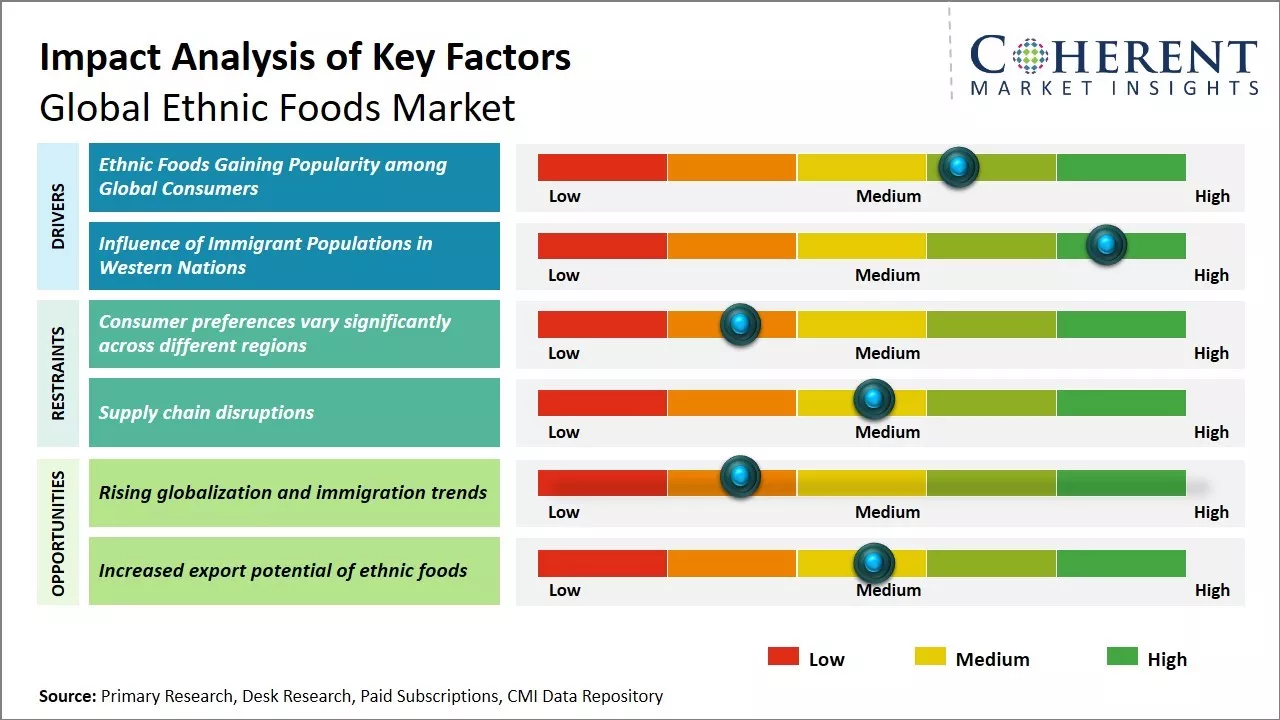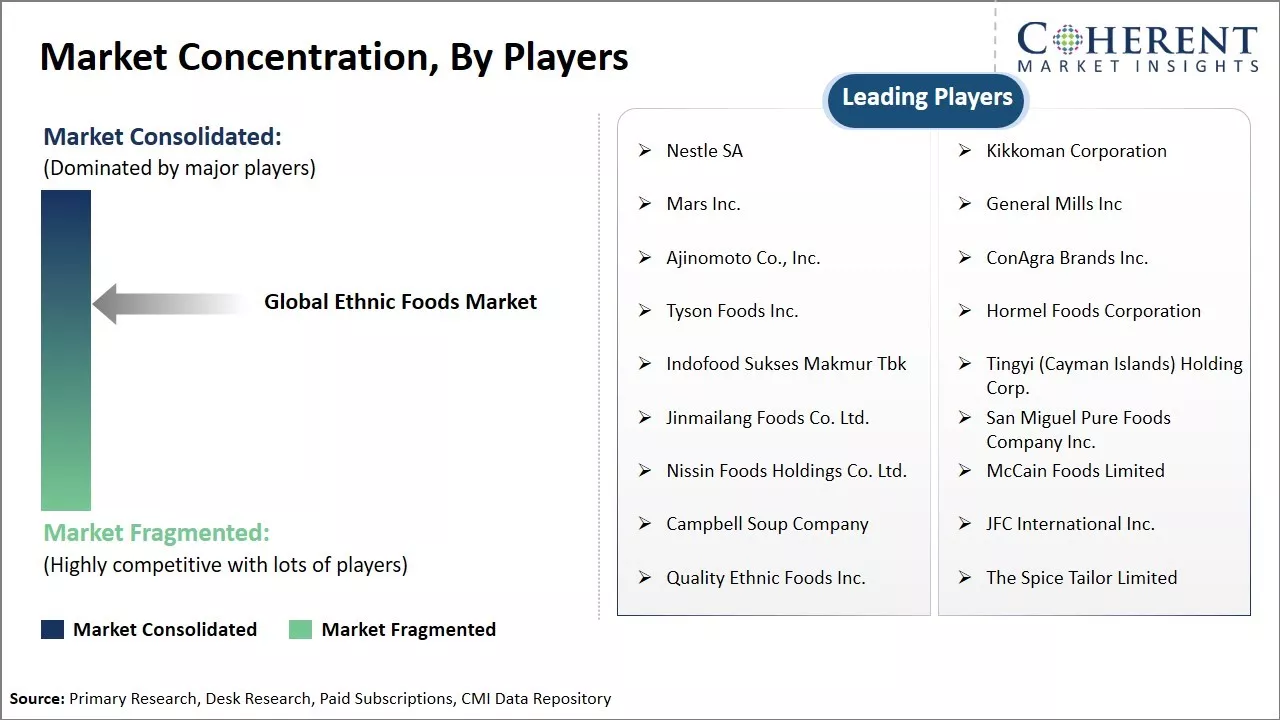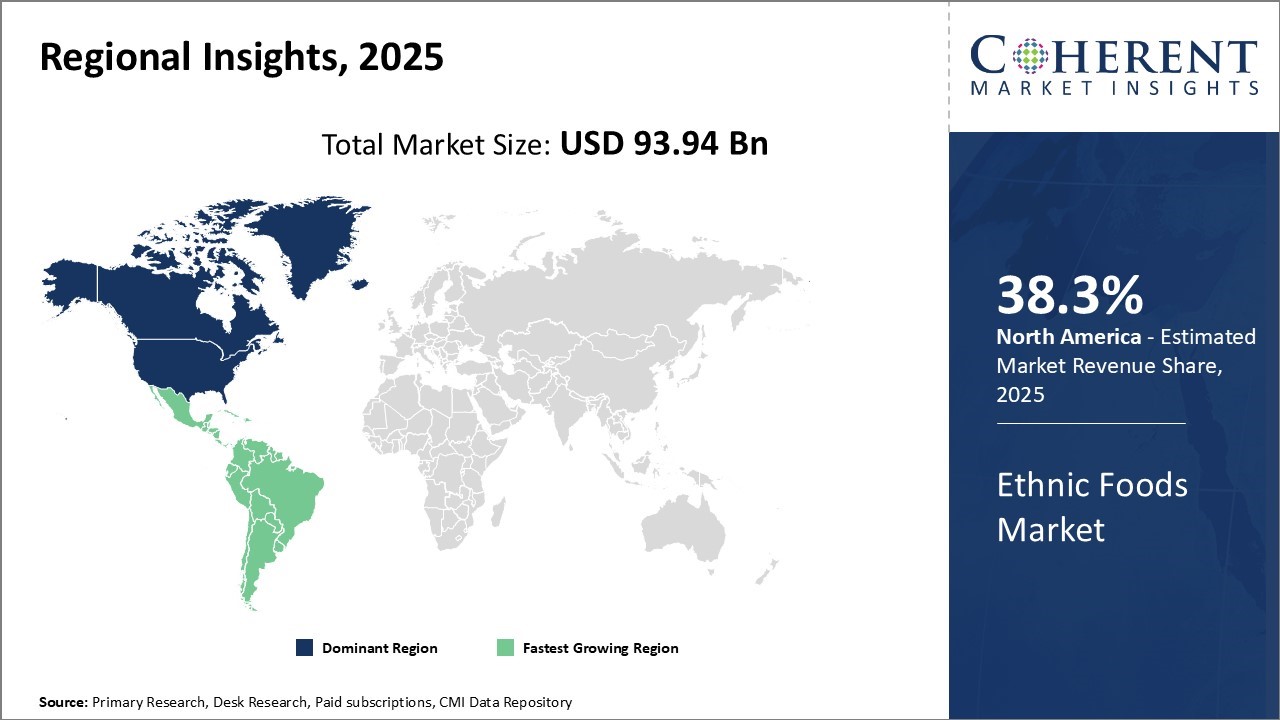The global ethnic foods market is estimated to be valued at USD 93.94 Bn in 2025 and is expected to reach USD 154.94 Bn by 2032, growing at a compound annual growth rate (CAGR) of 7.4% from 2025 to 2032.

To learn more about this report, Download Free Sample
The popularity of global value cuisine is significantly increasing owing to globalization waves, changes in immigration patterns, and traveling populations. Specialty foods and cuisines are greatly sought after because of frequent traveling and exposure through social media. The worldwide popularity of Mexican cuisine street foods like tacos is a great example. The ethnic food market in the United States is driven largely due to the availability of unique ingredients and intercultural contact, making the foods easy to prepare, and thus appealing to all people. Over the next several years, this trend is anticipated to continue increasing growth in ethnic food products around the globe.
|
Event |
Description and Impact |
|
Inflation and Economic Pressures on Consumer Spending |
|
|
Climate Change and Agricultural Impacts |
|
|
Digital Transformation and E-commerce Growth |
|
Uncover macros and micros vetted on 75+ parameters: Get instant access to report
The global ethnic foods market, valued at $78.5 billion in 2023 and projected to surpass $115 billion by 2028, showcases diverse pricing structures influenced by authenticity, brand positioning, packaging, and distribution channels. Price ranges vary widely across cuisine categories and regions.
Asian cuisine products reflect tiered pricing, with sauces like Lee Kum Kee Oyster Sauce retailing between $2.99–$4.99 and premium options like San-J Organic Tamari reaching $8.99. Frozen items such as Bibigo Dumplings cost $8.99–$12.99, while pantry staples like Jasmine Rice (5kg) range from $12.99–$18.99.
Latin American foods remain competitively priced, with hot sauces like Cholula at $2.99–$4.49 and prepared foods such as El Monterey Burritos ranging $6.99–$9.99. Maseca Corn Flour, a staple item, is priced between $3.99–$5.99.
Indian products offer value across spice blends and ready meals. Patak’s Curry Paste retails at $3.99–$6.49, and Tasty Bite ready meals cost $2.99–$4.99.
Pricing is generally higher for organic and clean-label offerings, with specialty brands commanding premiums in Western markets. Online platforms often offer wider ranges and occasional discounts, while supermarkets maintain stable mid-range pricing for mass-market appeal.
Advanced technology is revolutionizing the ethnic foods market, especially as demand rises among millennials seeking authenticity, health-conscious options, and convenience. High-pressure processing (HPP) and freeze-drying innovations preserve flavor and extend shelf life for clean label ethnic food products, while smart packaging with QR codes offers cultural context and preparation guidance—key for engaging younger, digitally native consumers.
Automation and robotics are enhancing production of traditionally handmade items such as naan and dumplings, supporting scalability for premium ethnic food product launches. AI and machine learning are powering recipe development tailored to local tastes and dietary trends, fueling growth in the direct-to-consumer ethnic food market and ethnic food recipe kits market.
Technologies like blockchain and IoT are enabling traceability and quality assurance, critical for consumer trust in specialty markets such as the halal food market. Meanwhile, temperature-sensitive packaging and smart warehousing ensure product integrity across global supply chains.
The rise of the ethnic food vending machine market also illustrates how tech is transforming accessibility, providing on-the-go consumers with authentic meals. Altogether, these innovations are bridging cultural authenticity with modern convenience, expanding the ethnic foods market’s appeal across generations and regions.
Consumer demand for organic and clean label ethnic food products is accelerating rapidly, driven by growing health awareness, ingredient transparency, and lifestyle shifts toward natural eating. Shoppers—particularly millennials and Gen Z—are seeking ethnic foods made without artificial additives, preservatives, or genetically modified ingredients, while still delivering authentic taste and cultural richness.
Brands are responding by reformulating traditional ethnic recipes using organic ingredients and simplified labels. Products like organic Indian curry sauces, preservative-free Korean kimchi, and gluten-free Mexican tortillas are gaining traction across mainstream supermarkets and specialty retailers alike.
The clean label trend is especially prominent in ready-to-eat ethnic meals, spice blends, and condiments, where consumers demand full ingredient transparency without compromising on flavor. Certifications such as USDA Organic, Non-GMO Project Verified, and allergen-free labeling further boost consumer trust.
As part of the broader wellness movement, this demand is reshaping product innovation and marketing strategies in the ethnic foods market. Companies embracing organic and clean label formulations are capturing premium market share while appealing to environmentally and socially conscious consumers.

To learn more about this report, Download Free Sample
With increasing globalization and popularity of international travel, people are getting more exposed to different cultures and their foods. This has fueled tremendous curiosity among consumers to experiment with new flavors from various world cuisines. Food has become one of the most direct and authentic ways through which people can experience different cultures. Moreover, with the influence of global media and internet, ethnic recipes and ingredients are easily accessible even in remotest of regions.
Food bloggers and YouTube channels dedicated to international cuisines have inspired home chefs to recreate dishes from around the world. The current generation of millennials and Gen Z especially shun monotonous diets and prefer exploring diverse flavors over repetitive menus. They consider ethnic foods trendy and like to flaunt their experimental tastes on social media.
All these factors have encouraged consumers to step out of their culinary comfort zones and regularly try out cuisines like Mexican, Indian, Thai, Italian, etc., driving the demand for global ethnic ingredients.
Countries like the U.S., Canada, the U.K., and other parts of Europe have seen rapid rise in immigrant populations from Asia Pacific and Latin America over the past few decades. These immigrant communities bring along authentic cuisines from their home countries and introduce them to the local populations. They set up ethnic grocery stores and restaurants serving their native cuisine which helps in popularizing these foreign flavors among non-native consumers.
The second and third generation children of immigrants also take pride in their culinary heritage and actively participate in promoting their ethnic cultures. This has tremendously boosted the demand for ingredients integral to those world cuisines.
Moreover, the increasing multicultural character of western societies has made people more receptive and inclusive towards immigrant foods and cultures. The ethnic enclave neighborhoods act as thriving markets for these exotic ingredients to serve both native and immigrant consumers in large metropolitan areas.
Consumer preferences vary significantly across different regions due to cultural and social influences. Meeting these varied tastes requires flexible production and supply chains. Stringent import regulations in some countries also impact product availability. Moreover, authenticity and quality standards are difficult to consistently maintain across international markets. Creating wider brand awareness and consumer trust remains an ongoing challenge.
Rising globalization and immigration trends are increasing the exposure and demand for ethnic cuisines worldwide. Customers are more willing to experiment with new food flavors and ingredients. The growth of online retail further aids the distribution of niche ethnic products. Manufacturers can examine value-added product innovations to appeal new customers. There is scope to partner with local restaurants and retailers to gain market insights as well as boost sales prospects.
In terms of cuisine type, Asian contributes 39.1% share of the market owing to growing interest in diverse flavors from across the continent in 2025. Asian cuisine encompasses the preparations and cooking techniques of various countries in East, Southeast, and South Asia, with some common threads that appeal greatly to globalized palates. Chief among these is the creative use of herbs and spices to create vibrant, layered dishes.
Cuisines from countries like Thailand, China, Japan, India, and Malaysia tend to highlight a balance of tastes like salty, sour, sweet, and pungent that Western palates have come to enjoy. The traditional recipes handed down for generations in these cultures offer diners authentic taste experiences that spark curiosity. Iconic dishes representing each region's cuisine have gained mass popularity worldwide - from Indian butter chicken and tandoori to Thai green curries and pad Thai.
While originally niche, ethnic restaurants featuring these cuisines have spread internationally due to their widespread appeal. Home chefs also seek to recreate favorites from Asian cookbooks and online videos. Younger generations in particular have embraced Asian influences in food as an expression of openness to new experiences and cultures. The availability of high-quality imported ingredients has also supported market growth for Asian cooking.
Supermarkets stockpile must-have seasonings from different parts of Asia. Online retailers offer specialty items that allow home chefs to achieve restaurant-quality results. As globalization increases cultural sharing, interest in Asian cuisine looks set to remain strong given its healthy perceptions, abundance of flavor profiles to discover, and connection to traditions valued across Asia Pacific.
In terms of food type, the veg segment contributes 62.9% share due to growing consumer health consciousness and demand for diverse plant-based dishes in 2025. Ethnic vegetable preparations tend to be perceived as more nutritious alternatives to meat-heavy Western recipes. Their complex, robust flavors satisfy even without meat proteins.
Additionally, religions espousing vegetarianism like Hinduism, Buddhism, and certain sects encourage innovative vegetable-focused ethnic cooking. Cuisines like Indian, Thai, Ethiopian, and Middle Eastern emphasize vegetables, grains, and legumes in delightful curries, stir fries, and stews. Iconic dishes like saag paneer, thai green curries, and tajines feature seasonal produce prominently. This variety sparks home chefs' interest in creating exciting veg-centered meals instead of relying on the same old standards. Supermarkets dedicate more shelf space to international produce and ingredients to meet the rising preference.
Additionally, environmental and ethical concerns galvanize more flexible, plant-based diets. Younger generations seeking to reduce meat consumption are especially attracted to flavorful veg ethnic foods. As these options proliferate commercially and popularity rises, their appeal will likely carry over to health-conscious Western palates for balanced, satisfying fare minus the meat. The numerous veg-focused options across world cuisines maintain this segment's strong market presence.
In terms of distribution channel, hypermarkets/supermarkets contribute 38.3% share to the ethnic foods market due to unmatched product range and shopping convenience in 2025. Their large store formats allow featuring entire international food sections with global ingredients and preparations together. Shoppers benefit from comparing and selecting from a comprehensive assortment under one roof.
Consistently stocking staple ethnic ingredients also appeals to time-starved consumers who occasionally cook international dishes. Hypermarkets focus on deep assortments to attract greater footfall from different customer profiles. Their buying power means importing larger quantities directly from culturally authentic brands. This ensures best quality and prices. Compelling product displays, promotions, and recipes further stimulate impulse buys and return shopping trips dedicated to ethnic cooking essentials.
Consumers doing major top-up shops for relatives or entertaining value hypermarket infrastructure like specialized deli and fresh food counters too. Staff expertise guides novices among eclectic offerings. Overall, the one-stop shopping experience and guarantee of globally diverse supplies drives this channel's dominance in the multicultural sector. Retailers pledge ongoing new market and supplier partnerships to stay ahead curating cuisine experiences for growing customer bases.

To learn more about this report, Download Free Sample
North America is set to maintain its dominant position in the global ethnic foods market in 2025, capturing a commanding 38.3% share of the total market. This leadership is primarily driven by the region’s large and diverse immigrant population, which creates strong demand for authentic ethnic cuisines spanning Latin American, Asian, African, and European flavors.
The U.S. leads this market with a well-established ethnic foods industry concentrated in multicultural urban centers such as New York, Los Angeles, Chicago, and Miami. These cities host vibrant ethnic enclaves producing and distributing a wide variety of international food products. In response to growing consumer demand, mainstream grocery retailers have significantly expanded their world foods sections, making ethnic ingredients and ready-to-eat products widely accessible.
Popular ethnic cuisines like Mexican, Chinese, Indian, and Italian have become staples of the North American diet, supporting food companies that deliver authentic, high-quality products at competitive prices. Additionally, a growing number of ethnic entrepreneurs and specialty restaurants further energize the market. The combination of a large consumer base and dynamic food culture makes North America a lucrative region for both domestic and international ethnic food producers.
Asia Pacific is emerging as the fastest-growing region in the global ethnic foods market, driven by rising disposable incomes, rapid urbanization, and shifting consumer tastes across key countries including Indonesia, Thailand, Malaysia, the Philippines, and Vietnam. Western influences and growing middle classes are expanding demand for diverse ethnic food products.
Domestic consumption of native ethnic cuisines is strengthening as traditional foods gain acceptance both nationally and regionally. Simultaneously, Southeast Asian specialties such as Vietnamese spring rolls, Malaysian laksa, Thai green curry, and Filipino adobo are gaining increasing popularity on the global stage. Leading food exporters in the region are capitalizing on this trend by expanding international distribution networks.
The rich and varied culinary traditions unique to each Southeast Asian nation represent a core strength for the region’s ethnic foods market, positioning Asia Pacific as an influential and rapidly expanding player in the global industry.
Indonesia dominates the Southeast Asian ethnic foods sector, fueled by its vast population and deeply rooted food culture. Urbanization and growing disposable incomes are boosting demand for both local Indonesian foods and imported ethnic products. Popular dishes like nasi goreng and satay drive domestic consumption, while investments in modern food processing and packaging enhance export potential. Government initiatives supporting food manufacturing and tourism further stimulate market growth.
Thailand’s ethnic foods market benefits from the international acclaim of its cuisine, exemplified by dishes such as Thai green curry and pad thai. The country’s strong tourism sector has popularized Thai food worldwide, increasing export volumes. On the domestic front, consumer interest in healthy and convenient ethnic food options is rising, supported by government efforts to promote Thai cuisine globally and improve food safety regulations.
Malaysia’s ethnically diverse population contributes to a rich ethnic foods market featuring Malay, Chinese, and Indian cuisines. Rising urbanization and a growing middle class drive demand for packaged ethnic foods in retail and foodservice. Malaysia is also a leading producer of halal-certified ethnic foods, catering to Muslim consumers regionally and internationally. Strategic geographic location and government incentives aimed at food innovation bolster Malaysia’s role as a regional hub.
| Report Coverage | Details | ||
|---|---|---|---|
| Base Year: | 2024 | Market Size in 2025: | USD 93.94 Bn |
| Historical Data for: | 2020 To 2024 | Forecast Period: | 2025 To 2032 |
| Forecast Period 2025 to 2032 CAGR: | 7.4% | 2032 Value Projection: | USD 154.94 Bn |
| Geographies covered: |
|
||
| Segments covered: |
|
||
| Companies covered: |
Nestle SA, Kikkoman Corporation , Mars Inc. , General Mills Inc, Ajinomoto Co., Inc. , ConAgra Brands Inc., Tyson Foods Inc. , Hormel Foods Corporation , Indofood Sukses Makmur Tbk , Tingyi (Cayman Islands) Holding Corp. , Jinmailang Foods Co. Ltd. , San Miguel Pure Foods Company Inc. , Nissin Foods Holdings Co. Ltd. , McCain Foods Limited , Campbell Soup Company, JFC International Inc., Quality Ethnic Foods Inc., and The Spice Tailor Limited |
||
| Growth Drivers: |
|
||
| Restraints & Challenges: |
|
||
Uncover macros and micros vetted on 75+ parameters: Get instant access to report
Share
Share
About Author
Sakshi Suryawanshi is a Research Consultant with 6 years of extensive experience in market research and consulting. She is proficient in market estimation, competitive analysis, and patent analysis. Sakshi excels in identifying market trends and evaluating competitive landscapes to provide actionable insights that drive strategic decision-making. Her expertise helps businesses navigate complex market dynamics and achieve their objectives effectively.
Missing comfort of reading report in your local language? Find your preferred language :
Transform your Strategy with Exclusive Trending Reports :
Frequently Asked Questions
Joining thousands of companies around the world committed to making the Excellent Business Solutions.
View All Our Clients